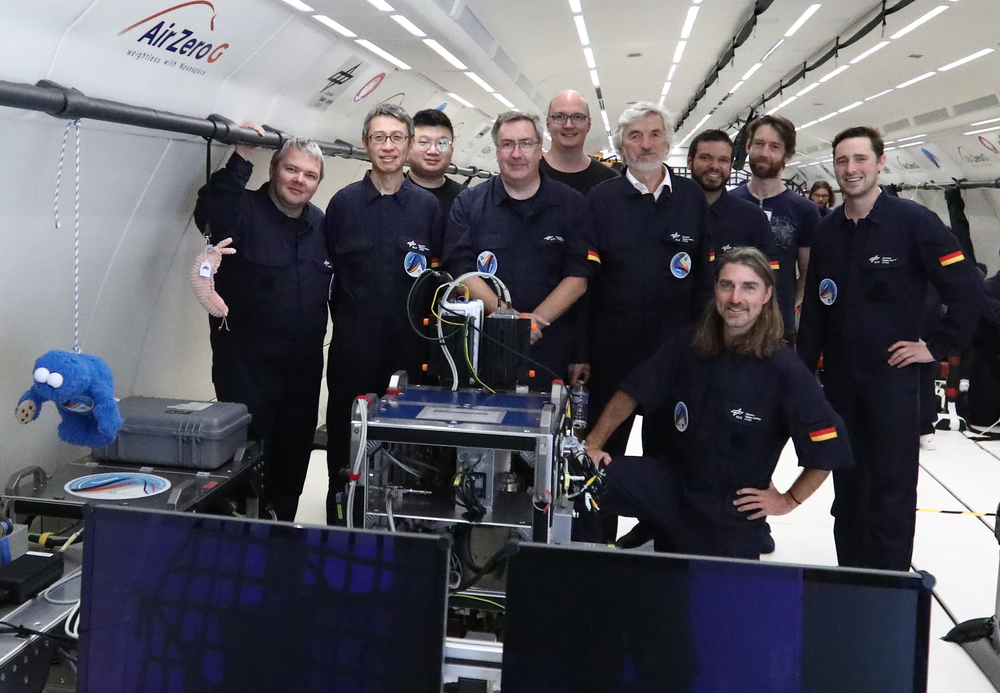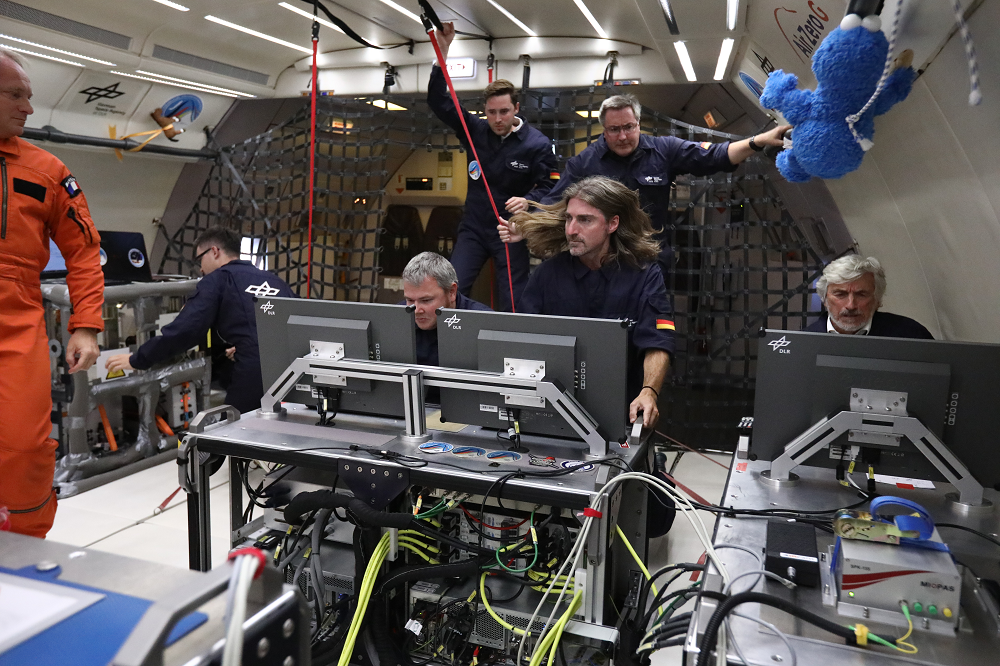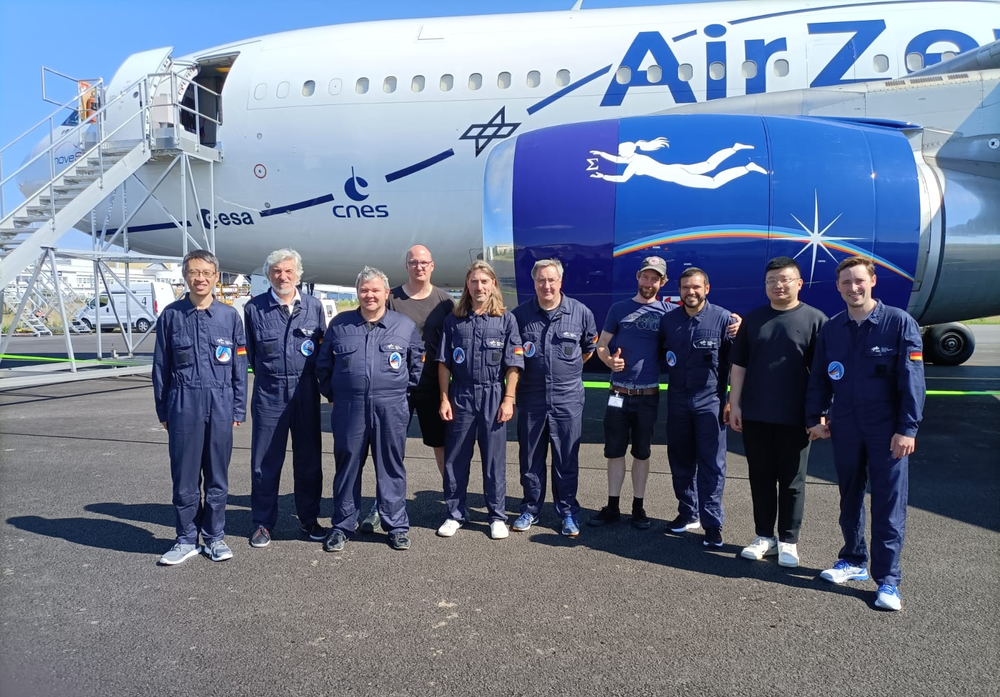TEMPUS experiments at the 41st DLR parabolic flight campaign

Novespace

Novespace

Novespace
- The Institute of Materials Physics in Space successfully conducted TEMPUS experiments from 4-15 September 2023 as part of the 41st DLR Parable Flight Campaign
- During the campaign, innovative materials such as glass-forming systems, high and super entropy alloys and alloys suitable for 3D printing were tested.
- The experiments were carried out by an international team of researchers from various universities and institutes and supported by ESA in collaboration with the German Space Agency.
- Focus: Parabolic flight, weightlessness experiments, additive research.
Employees of the DLR Institute of Materials Physics in Space successfully took part in the 41st DLR parabolic flight campaign from 4-15 September 2023 with the TEMPUS experiment (crucible-free experimentation and processing in microgravity). The experiments were selected in May 2023 and have since been intensively prepared by user support staff. The flights were carried out at Bordeaux-Merignac Airport by Novespace in an Airbus A310 Zero-G. The installation of the system in the Airbus took one week, in the second week the flights were carried out on 3 days and the experiments were optimised with regard to the experiences of the first flight days.
In addition to the system operators from the Institute of Materials Physics in Space, two additional experimenters flew on each flight day, specifically from the universities of Jena, the Technical University of Munich, the University of Alberta (Canada) and the Institute of Materials Physics in Space. The planning and realisation was carried out on behalf of ESA and the flight opportunity was provided by the German space agency. The experiments were tendered and selected in equal shares by the three parties.
The TEMPUS system and electromagnetic levitation
TEMPUS is a facility for electromagnetic levitation (EML) that is operated, maintained and continuously developed by the Institute of Materials Physics in Space. In TEMPUS, metallic conductive, spherical samples are held in suspension in a coil by an alternating electromagnetic field, melted and measured. Thermophysical properties of the melt such as viscosity, surface tension, density and electrical conductivity are investigated, as well as the solidification behaviour, i.e. measurement of the speed and form of solidification and subsequent analysis of the microstructure of undercooled solidified samples. In contrast to ground-based systems, only small forces or fields are required to hold the sample in position during the approx. 21 seconds of each parabola due to the lack of gravity. The container-free method also allows measurements to be carried out on reactive materials and in the metastable state of the supercooled melt.
The flown experiments included glass-forming systems, super and high-entropy alloys, systems in the context of additive manufacturing, a Scalmalloy alloy for 3D printing processes (patent: Airbus DS), as well as optimised steel. Vanadium with and without controlled oxygen content and binary model systems were also investigated.
The latter included a world premiere, i.e. the first optical measurement in molten, levitated Al-Si alloys in zero gravity using a fibre Bragg grating. This experiment required special preparation and supervision, which culminated in the particularly successful realisation of the experiment.
A high-speed camera was used for all experiments from the radial viewing direction and a thermal imaging camera was also used on the second flight day, while the axial camera system ARES, which was built at the Institute and used in flight for the first time, was successfully used in the axial direction, enabling recording frequencies of up to 2 kHz.
Eine Übersicht über die prozessierten Proben:
Institute for Materials Physics in Space:
- Al-Si-Fe, with increased iron content in the context of additive manufacturing
- Vanadium and vanadium oxide as part of the OXYTHERM project
- Scalmalloy, an alloy patented by Airbus DS for 3D printing applications
ESA:
- Inconel 718, an austenitic nickel-chromium based superalloy (Tufts University, USA)
- Al-Ni as part of the NEQUISOL project (University of Jena, Germany)
- 17-4 PH steel (University of Alberta, Canada)
- Ni-B-Si (University of Alberta, Canada)
DLR Space Agency:
- Ni-Nb-P: Glass former (Saarland University)
- Al-Si: World first in parabolic flight: optical measurement in the fibre Bragg grating in a levitated sample (TU Munich)
- Zr-Cu-Ni: Glass former (University of Jena)
- Zr-Ti-Ni-Cu-S: Glass former (Saarland University)
Ultimately, the video and system data will be archived in a data archive, which scientists can use to download their data via the Internet. The archive is based on the Hypertest architecture and is operated by the Microgravity User Support Centre (MUSC).
